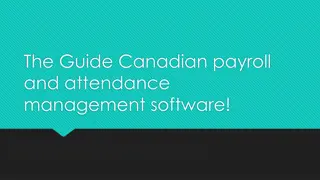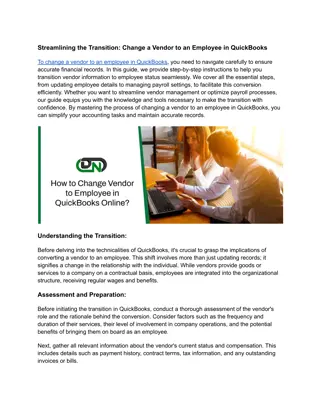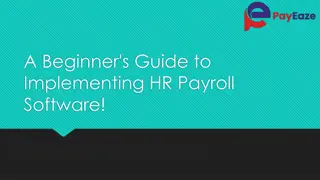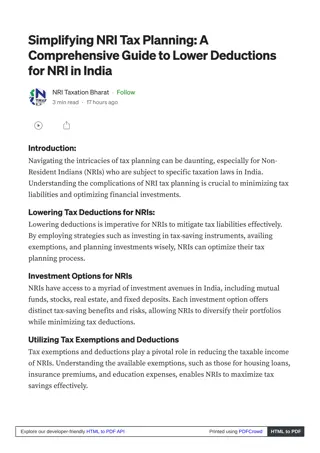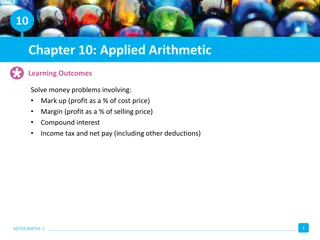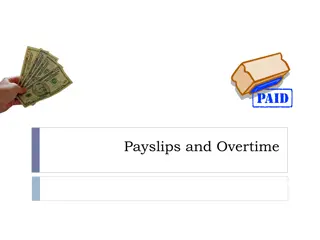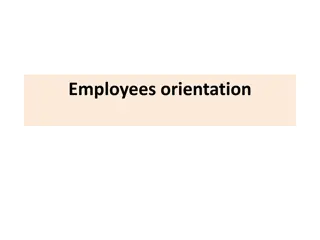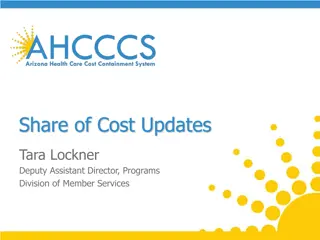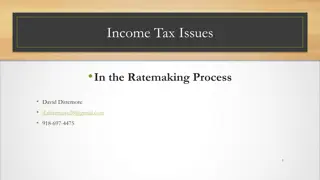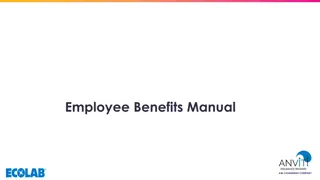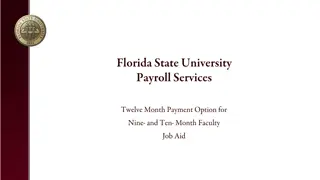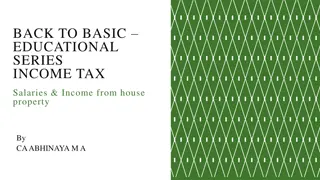
Guidelines for Claiming Work from Home Expenses: 2023 Financial Year
Learn about the Revised Fixed Cost Method for claiming work from home expenses in the financial year 2023. Explore eligibility criteria, allowable deductions, calculation methods, and record-keeping requirements. Understand what expenses can be claimed separately and how to maximize your deductions efficiently.
Download Presentation

Please find below an Image/Link to download the presentation.
The content on the website is provided AS IS for your information and personal use only. It may not be sold, licensed, or shared on other websites without obtaining consent from the author. If you encounter any issues during the download, it is possible that the publisher has removed the file from their server.
You are allowed to download the files provided on this website for personal or commercial use, subject to the condition that they are used lawfully. All files are the property of their respective owners.
The content on the website is provided AS IS for your information and personal use only. It may not be sold, licensed, or shared on other websites without obtaining consent from the author.
E N D
Presentation Transcript
Deductions for a Deductions for a typical employee typical employee for the 202 for the 2023 3- -2 24 4 financial year financial year
Two calculation methods Revised Fixed Cost Method Actual Cost Method Work from home expense
Work from home expense Revised Fixed Cost Method Eligibility: incur additional running expenses as a result of working from home be working from home to fulfil your employment duties, not just completing minimal tasks records that show all the hours you work from home for the entire year records showing evidence that you paid for the expenses covered by the revised fixed rate method Using this method: You can claim the fixed rate of 67 cents for each hour you worked from home. The rate includes the additional running expenses you incur for: Data and internet Electricity and gas Mobile and home phone usage Computer consumables (e.g. printer ink) Stationery
Work from home expense Revised Fixed Cost Method You cannot claim a separate deduction for any of the expenses that the revised fixed rate includes. However, you can claim a separate deduction for: a. The decline in value of assets used while working from home, such as computers and office furniture b. The repairs and maintenance of these assets c. Cleaning (only if you have a dedicated home office) Calculation: WFH expense = 67 cents no. of hours worked from home + separate deductions for any work-related expenses in categories a, b, and c
Work from home expense Revised Fixed Cost Method To claim the work-related portion of your working from home expenses, you must keep: a record of the all of the hours you worked from home during the income year (From 1 March 2023, a record of all the hours worked is required). receipts or other written evidence that shows the amount spent on expenses and depreciating assets you purchase a diary that shows the percentage of the year you use your depreciating assets exclusively for work
Work from home expense Revised Fixed Cost Method If include Claim Separately Expense Category Electricity and gas yes No Internet expenses yes No Phone usage yes No Stationery and computer consumables yes No Work-related furniture No Depreciation or immediate deduction if $300 Technology No Depreciation or immediate deduction if $300 Repairs and maintenance No Yes Occupancy expenses No Only in limited cases with a dedicated home office Cleaning expenses No Only in limited cases with a dedicated home office
Work from home expense - Actual Cost Method Eligibility: incur additional running expenses as a result of working from home be working from home to fulfil your employment duties, not just completing minimal tasks records of receipts, bills or invoices, records showing the amount you spent on depreciating assets you use whilst working at home, and records showing evidence of your personal and work-related use of the items or services you buy and use Keep records: receipts, bills or invoices which show the supplier, amount of the expense, nature of the goods, date it was paid and date of the document evidence of the amount you spend on depreciating assets you buy and use while working from home evidence of your personal and work-related use of the items or services you buy and use (can work this out using records for the entire year or over a 4-week period that represents your work use for example, using a diary or itemized bill)
Work from home expense - Actual Cost Method Using the actual cost method, you work out your deduction by calculating the actual expenses you incur to produce your income when working from home. This may include the following expenses: Decline in value of depreciating assets such as home office furniture (desk, chair) and furnishings, phones and computers, laptops or similar devices If the asset s value is higher than $300 or forms part of a set that together cost more than $300, you may have to depreciate it If the asset s value is less than $300, you could claim as a deduction right away Regardless of the asset s value, if you also use it for private purposes, only work-related value is deductible Cleaning expenses, if you use a dedicated area for working You could work out the cost of your cleaning expenses and apportion your claim for any: private use of your home office use of the home office by other members of your household. For example, if you have a room set up as a home office, add together your receipts and multiply by the floor area of the dedicated work area, divided by the whole floor area of the house. Then reduce this amount by the percentage of private use by yourself and the use of the home office by other household members
Work from home expense - Actual Cost Method Heating, cooling and lighting electricity and gas Work out the cost of your heating, cooling and lighting by using the: cost per unit of power used (your utility bill has this information) average units used per hour, which is the power consumption per kilowatt (electricity) or per megajoule (gas) hour for each appliance, equipment or light used total annual hours used for work-related purposes by checking your record of hours worked or your diary. Phone and internet (work-related) Computer consumables and stationery (work-related) such as printer ink
Work from home expense Actual Cost Method Eligible Expenses Category Depreciating Assets Decline in value of home office furniture (desk, chair), furnishings, phones, computers, laptops, or similar devices Electricity and Gas Heating, cooling, and lighting used for work purposes Phone, Data, and Internet Home and mobile phone expenses, data usage, and internet expenses (based on the work-related portion) Stationery and computer consumables Items like printer ink, paper, and other stationery or consumables used for work purposes Cleaning Cleaning expenses for your dedicated home office space (apportioned for work-related use) Occupancy Expenses (Limited Cases) Mortgage interest or rent (in limited cases, subject to eligibility)
Work-Related Car Expense Only expense incurred in travelling between workplaces is deductible, the travel expense spent on commuting between home and workplace is not deductible. o Note that you can also claim the travel between work and school, if you are claiming deductible self-education. Car expense: o If you use cents per kilometre method, you can claim up to 5000 kilometres related to work per year at the rate of 85 cents per kilo for the past financial year. However, no other expenses can be claimed on top of that. To calculate your deduction, multiply the number of business kilometres you travel in the car by the appropriate rate per kilometre for that income year. o If you use logbook method, you could claim expenses spent on registration, fuel, insurance, repair and depreciation, but renovation is disallowed. In order to use this method, you need to have a logbook showing a continuous and representative 12- week period. o Exemption for itinerant workers and those carrying bulky tools, who can claim work-to- home trips Public transportation: o Deductible based on actual expenses incurred and only between workplaces
Work-Related Travel Expense you must have spent the money yourself and weren't reimbursed it must be directly related to earning your income you must have a record to prove it (usually a receipt). You can only claim a deduction for the work-related portion of an expense. You can't claim a deduction for any part of an expense that is not directly related to earning your income or that is private. If your total claim for work-related expenses is more than $300, you must have written evidence to prove your claims. Work-related travel expenses include: public transport, air travel and taxi fares short-term car hire accommodation, meal and incidental expenses you incur while away overnight for work actual expenses such as petrol, repair and maintenance costs, that you incur to travel in a car that is owned or leased by someone else bridge and road tolls, and parking fees for cars (don't claim these at 'Work-related car expenses') motorcycles and vehicles with a carrying capacity of one tonne or more, or 9 or more passengers expenses for motorcycles and vehicles with a carrying capacity of one tonne or more, or 9 or more passengers, such as utility trucks and panel vans.
Work-Related Clothing, Laundry, and Dry- Cleaning Expense Expenses on buying, hiring, mending or cleaning uniform can be deductible if taxpayers have not been reimbursed by their employers (Nb: the definition of uniform does not include conventional clothing that you can wear outside of work i.e. there must be some defining feature such as a logo) o For cleaning, if taxpayers clean the uniform at home: $1 per load if it only contains clothing you wear at work from one of the categories above 50c per load if you mix personal items of clothing with work clothing from one of the categories above. If your laundry claim is $150 or less (not including dry-cleaning expenses), you can claim the expense and don t need receipts. You will need to be able to show how you calculated your claim.
Work-Related Self-Education Expense You can claim self-education and study expenses if your course relates directly to your employment and it either: maintains or improves the skills and knowledge you need for your current duties results in or is likely to result in an increase in income from your current employment. Expenses not exclusively for study need to be apportioned You must have incurred the expense You cannot claim the expense if you have been reimbursed for it You must keep receipts for all expenses you incur
Work-Related Self-Education Expense Expenses include: Computer consumables You cannot claim repayments of study and training support loans such as: Higher Education Loan Program (HELP) (such as HECS-HELP, FEE- HELP and OS-HELP) Student Financial Supplement Scheme (SFSS) VET Student Loans (VSL) Student Start-up Loans (SSL) ABSTUDY Student Start-up Loans (ABSTUDY SSL) Trade Support Loans (TSL) Course and tuition fees Fees payable on some study and training support loans (that is, FEE-HELP and VET Student Loan), but not repayments on the loan itself Depreciation if the asset is less than $300 it can be immediately deducted Home office Interest Phone calls Postage and Stationery Student services and amenities fees Textbooks Journals relevant to the course Travel costs, including car expenses: - between home and your place of education - between your workplace and the place of education
Other deductions you may be eligible for Personal contribution to your super fund Assets that are directly related to your work, such as laptop, stationary Donations to Deductible Gift Recipients (DGRs) Need to be registered as a DGR otherwise amount is not eligible for a tax benefit The payment to tax agent for preparing your last-year tax return Will count towards your concessional contributions cap Check ATO website for things to consider when claiming and how to notify your super fund If the asset s value is higher than $300, you may have to depreciate it If the asset s value is less than $300, you could claim as deduction right away
Book a Free Consultation For eligibility criteria and bookings, visit rsa.anu.edu.au/anu-tax-clinic For any enquiries contact us at taxclinic@anu.edu.au Or call us on 02 6125 4853




